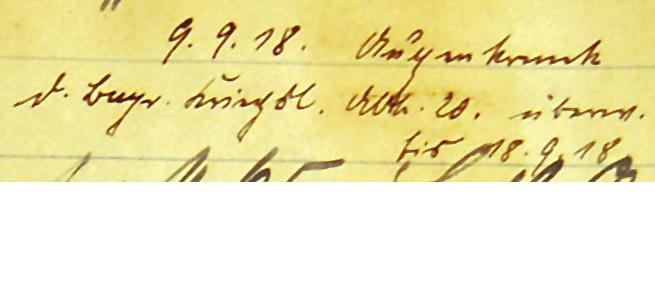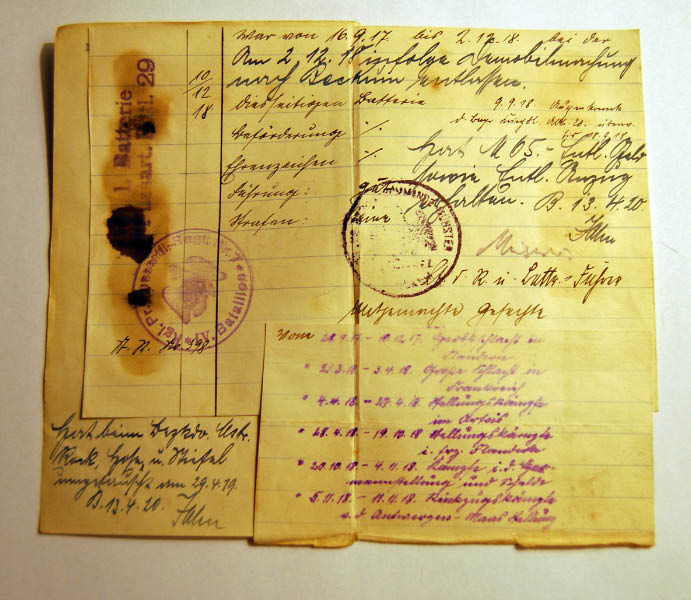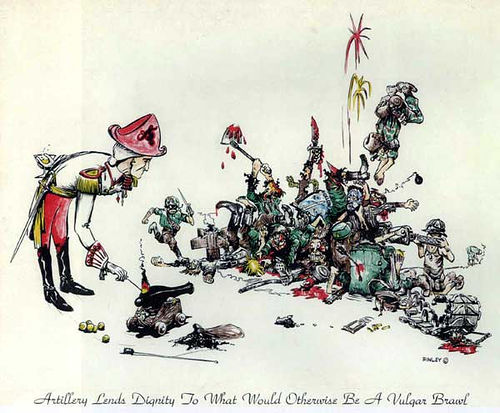-
Posts
5,629 -
Joined
-
Last visited
Content Type
Profiles
Forums
Blogs
Gallery
Events
Store
Posts posted by IrishGunner
-
-
Here's the part about being "krank" for about a week in September 1918. I think it tells which hospital "Lazerett Nr. 20" in which he spent the week. However, I can't make it out for sure. Anyone able to get the full text on this one?
 0
0 -
Pages with the last year of the war; 1918:
 0
0 -
-
I have finished my first translation/study of a Militärpass; a simple soldier.
Forty-one year old Friedrich Johann Steinkemper, married with two children, entered military service on 22 December 1916 as a Landwehr recruit. A machinist from Beckum in Westphalia, Steinkemper was entered into the rolls as a kanonier in Fussartillerie Regiment Nr. 7, garrisoned in nearby Köln. At the beginning of 1917, he was transferred to Landwehr Fussartillerie Battalion 32; spending three months with 6. Batterie before being assigned to the Battalion's 4. Batterie. For unknown reasons, a stamp from Fussartillerie Battatlion 57 appears in his Militärpass on the page assigning him to 4. Batterie Fussartillerie Battalion 32. From April to August 1917, Steinkemper saw his first combat during battles along the Yser River and in Flanders. From August to September 1917, he returned to the Ersatz Battalion, Fussartillerie Regiment Nr. 7. He saw duty at the front for only a week with 2. Batterie Fussartillerie Regiment Nr. 7 before he was re-assigned to 1. Batterie Fussartillerie Battalion 29. Steinkemper spent the remainder of the war with Fussartillerie Battalion 29, seeing action during the final battles of 1917 in Flanders. In 1918, Steinkemper and Fussartillerie Battalion 29 fought with the 9. Reserve Division against the British from the „Große Schlacht in Frankreich“, through battles in Artois and French Flanders, to the Retreat from Antwerp and Maas. Kanonier Steinkemper was a simple soldier; never promoted and never decorated. He survived the war without being wounded, although he spent a week in the hospital in September 1918 with an unknown illness. Steinkemper was demobilized by Fussartillerie Regiment Nr. 7 on 2 December 1918; on 7 December he was given a train pass to return to his family at Grûner Weg 11, Beckum, Westphalia.
0 -
A few new bits of info regarding Fuss-Artillerie Regt Nr. 1 ... adapted from http://www.lexikon-der-wehrmacht.de/
The following Wehrmacht generals started their military careers or served during WWI in Fuß-Artillerie-Regiment von Linger (Ostpreußisches) Nr.1.
Generalfeldmarschall Milch, Erhard; Erhard Milch entered Fuß-AR 1 as a Fahnenjunker on 24 February 1910. In autumn of the same year, he became a Fähnrich and received an appointment as a lieutenant on 18 August 1911 in the same regiment. He assumed duties as a battery officer; however, in the summer of 1915 he transferred to the Fliegenden Truppe and was assigned to Artillerie-Flieger-Abteilung 205. He subsequently served as Adjutant of the Artillerie-Fliegerschule Ost and several different flying units. During WW I he earned both the Iron Cross First and Second Classes. On 1 February 1939, Milch became the Generalinspekteur der Luftwaffe, a position he held until 1945..
Generalleutnant Usinger, Christian; Christian Usinger volunteered for military service on 1 August 1914 as a Kriegsfreiwilliger, joining Fuß-AR 1. He reached the rank of lieutenant in 1915 and served with the regiment throughout WWI. In the summer of 1939, he was given command of an artillery regiment. He held several higher level artillery commands during WWII and assumed command of the 223. Infantrie Division on 20 October 1942. He also commanded the 81. Infanterie-Division for a period in 1944. He ended the war in command of I. Armee Korps on the Eastern Front.
General der Artillerie Lucht, Walther; Walther Lucht joined Fuß-AR 1 as a Fahnenjunker on 27 June 1901; by October 1911 he had achieved the rank of Oberleutnant and served with the regiment's 8. Batterie in Lötzen. On 1 January 1913, he assumed the position of Regimental Adjutant; later that year, he assumed command of the Kriegsakademie in Berlin. With the beginning of WWI, he returned to the regiment as a battery commander. He received the Iron Cross Second Class on 4 November 1914; and later also the Iron Cross First Class. In 1916, he left the regiment and served on various headquarters staffs. At the end of WWI, he was serving on the staff of 75. Reserve-Division. Prior to the outbreak of WWII, he served as Artillery Commander for the Condor Legion in Spain, earning the Medalla de la Campaña de España, das Cruz de Guerra de España und das Spanienkreuz in Gold mit Schwertern. At the beginning of WWII, he commanded Artillerie-Regiment 215 and held several artillery commands early in the war. He assumed command of 87. Infantrie-Division on 17 February 1942, but only held that command for a short time before assuming command of 336. Infantrie-Divsion on 1 March 1942. He later commanded the LXVI. Reserve Korps, the LXVI Armee Korps, 15. Armee (during the Ardennes Offensive), 11. Armee, and the XII. Armee Korps.
0 -
I just googled Emilie Caldwell Stewart.
Wow; this book sounds exactly what I am talking about for WWI-era Militärpass.

"Wehrpass; 1994. This book was limited to 1000 copies. Soft cover and large 8.5 x 5.5 format, my reference book contains over 150 examples of original Wehrpass pages and beneath each reproduced page is a guide to what information is found on that page. My book helps you easily decipher Wehrpasses in your collection. Many of the examples were provided by the original German soldiers who were issued the Wehrpasses. Each page is fully described, translated and with codes deciphered. All branches of service are included. The back has a separate glossary of common abbreviations and medical codes found in Wehrpasses. This glossary cannot be found in any other reference book. Out of print."
I wonder how similar WWII Wehrpass are to WWI Militärpass? If this book would be helpful...
1000 copies; out of print. :banger:
0 -
Has anyone made their own tool to help with deciphering Militärpass?
I mean something that has translated the different sections of the document; the standard printed sections - not the written entries.
I speak German and can read the printed script fairly easily and am thinking of developing such a tool. But don't want to do work that maybe someone has already done and is willing to share.
 (David of www.militaerpass.net perhaps?)
(David of www.militaerpass.net perhaps?)I am also not talking about something to help decipher the hand-written script entries; that's a whole different story. Not easy in any case, but I am thinking with a tool that helps with the printed text, it makes laboring over the hand-writing a bit easier.
0 -
Does anyone else think the two 'LL's' in his name seem to be a different style ?
I wondered more about the colon " : " after BMBR than the L's. I haven't seen that before; but that doesn't mean a darn thing. I would think it odd to fake a common rank/name/regiment; but anything is possible.
0 -
Irish Gunner is correct about everything except the equivalency of the rank Bombardier. Currently Bombardier (2 chevrons) is equivalent to a Corporal in the Infantry, but during the Great War the Royal Artillery also had a rank of Corporal (two chevrons) so the rank of Bombardier (one chevron) fell between a Gunner (Private) and a Corporal, essentially equivalent to a Lance Corporal in the Infantry.
Regards, Gunner 1
Absolutely, stand corrected on Bombardiers. And I should have known better since I have WWI medals representing all ranks of the RA!

I answered too quickly and had a few Guinness. :cheers:
0 -
Noor;
RFA = Royal Field Artillery
RA = Royal Artillery
The Royal Artillery consisted of the RFA, RGA (Royal Garrison Artillery) and RHA (Royal Horse Artillery)
RFA is the field artillery - the lighter guns in direct support of the infantry
RGA is the heavy artillery - the bigger guns at corps and army level
RHA is light artillery serving with the cavalry
A BMBR = Acting Bombadier; a rank equal to acting corporal in other arms like the infantry
The Ubique badge is the regimantal badge for the Royal Artillery
The other badge you have; British Legion = is a veterans organization
You can download the Medal Index Card from the UK archives for 2 Brit Pounds; this will show you the medals he to which he's entitled. http://www.nationalarchives.gov.uk/documentsonline/medals.asp
0 -
Excellent! In that case, you will first have to go to the website and register. Then I can send you a link to the pages.
http://feldgrau.pyta...letin/index.php
Chip
I did this once before (remember the PMs?); now it doesn't remember me (can't log back-in) and my AV software says its an unsafe site. :unsure:
0 -
There are sites, but unless you know a bit of German (and just a bit will do) there isn't much for the English speaker.
Chip
Ahh, kein problem; Ich spreche Deutsch!

And Polish and Slovenian!

I'll take the web links now and put the book on my birthday wish list! :whistle:
0 -
IG,
Your source is correct for the Dunkelblau uniform. With the first field gray uniforms the foot artillery shoulder straps were field gray with white piping and red unit numbers, with the exception of,
The Guard Foot Artillery Regiment, which had no number or deivce.
The experimental battery of the Foot Artillery Testing Commission, which had a red monogram (APK) with a bursting bomb (still white piped).
The Lehr Regiment of the Foot Artillery Shooting School, which had a red monogram (FAS) with a bursting bomb.
In September of 1915 with the introduction of the new uniforms, the foot artillery shoulder straps were changed to a yellow-gold color with crossed "Langgranaten" and unit number in red.
Chip
Nice, thanks.
Can you recommend a written reference on uniforms?
0 -
Here you go http://www.kaiserscr...801/246822.html
Thanks to Irish Gunner, TomW it is up and running....... Soon to come, a photo section.....
Page looks great with the photo layout! Well done. :cheers:
0 -
Oh ye of little faith!
Hmm. The source I found online claims the shoulder straps are white with a red 1; at least on the 1914 blue waffenrock.
Did they change to these yellow types with the feldgrau uniforms? :unsure:
0 -
Hi,
if they are really really nice and I have an interest in the unit and/or action, i may go crazy and pay EUR10-15... if it was a real, real, real, real, real... killer piece, maybe a tad more.
A few years back guys were paying USD300-500 for some of the WW2 stuff, they would never get their money back on it today....
average WW1, maybe EUR1-4...
I guess I'm in the zone then; looking back I'm in the 3-7 EUR range. Though I was more like 20 for the lone Italian (who happens to be an artilleryman).
0 -
Well... there are a few things that would attract you...
1) You are Irish... and these are catholic!
2) Great research possibilities as they are very often bavarian and you can pull all the records of the guys online
3) as long as you stick to arty... we can still be friends! (Just kidding, there are more than enough of these to go around. Some guys are absolute idiots for what they are willing to pay for these!)
1) I'm only part Irish (one grandmother), but not Catholic.
2) Almost all are Bavarian that I have seen; except for the one Wuerttemburger and one Italian I've snagged.
3) Oh, I've already strayed from only artillery - the Wuerttemburger for example is not a gunner and I have a couple Bavarian infantrymen, which could be tradeable ;-)
So, what's the most you have spent for one? :whistle:
0 -
Alone on the thread!
Rick has .... um... pulled back to regroup.... uHem...!
I'm over on another site adding to my collection.

While you are here playing by yourself...
 Get's boring in the trenches, doesn't it?0
Get's boring in the trenches, doesn't it?0 -
If anyone knows what guns they are in the following series, please post...
Rhetorical question I presume... :cool:
0 -
Give it your best IrishGunner.... :-)
And lower myself into the trenches of what is otherwise a vulgar brawl? Not today mud boy. :cheers:
 0
0 -
Dude!
 And I thought we were going to be good friends.
And I thought we were going to be good friends. You do know what the "King of Battle" does to the "Queen of Battle" right?

(Who do I pay to get a smiley face firing a big gun instead of that piddling MG?)
0 -
Found this little piece to add to my small Sturmbataillon paper collection...
Oh, man, I just might be getting as crazy as you!

I just picked up a couple of these little death cards for artillery regiments to add to my regimental project.

Seems I've joined good collecting company. :beer:
0 -
Unfortunately, the original is fairly blurry too; it's on a post card, but only takes up about a third of the area. I am almost certain the ribbons are not EK black; they appear as almost all white in the photograph. (Would black EK ribbons washout to white in a photo of this era?)
Under x9 magnifying loop, I can see that the two ribbons on the left have a wider and lighter center stripe with narrower darker side stripes; suggesting to me that it's possible they are Bavarian MVK.
Another possibility would be the Wuerttemburg Military Merit Medal.
The problem is that I can't really make out any of the shapes of the medals; nothing comes clear as a EK shape. Nothing really looks round either.
So, it's a pure guess really, but I think they are Bavarians. Curious if anyone has evidence of an en masse awarding of the MVK. Seems logical.
0 -
Roll of Honor:
The following officers and soldiers have been identified as being part of Fuß-Artillerie-Regiment von Linger (Ostpreußisches) Nr.1.
Oberstleutnant Neumann; Regiments-Kommandeur (1914)
Oberstleutnant Richard; reported to have attended the Lehrgang für ältere Offiziere bei der Fußartillerie-Schießschule vom 20. November bis 18. Dezember 1904
Major Friese; reported to have attended the Lehrgang für ältere Offiziere bei der Fußartillerie-Schießschule vom 20. November bis 18. Dezember 1904
Leutnant d. Rsv Bering, Walter; KIA 1918-10-24; Burial Giżycko, Poland
Leutnant Ernest, Leop.; KIA 1914-11-2?; Burial Paprotki, Poland
Vizefeldwebel Albrecht, Gustav; KIA 1915-02-12; Burial Biała Piska; Poland
Obergefreiter Fiedler; KIA 1915-04-29; Burial Białaszewo, Poland
Kanonier Marquardt; KIA 1915-03-08; Burial Białaszewo, Poland
0





A group of new heroes
in Germany: Imperial: Rick (Research) Lundstrom Forum for Documentation and Photographs
Posted
Unfortunately, a completely blank reverse; not even a "printed by" name.